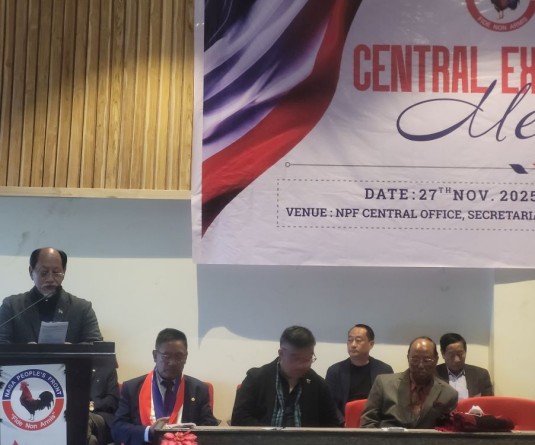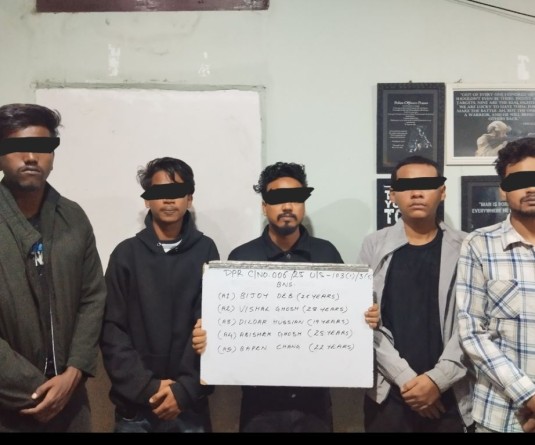
Tuensang: Tubers are modified plant structure enlarged to store food for the plant. Of the two types of tubers, i.e., stem and root tubers, more importance has been attributed to the root tubers in the diet of the common person. Their high contributions of carbohydrates in the limited availability of rice have made the tuber crops, particularly colocasia indispensable as energy source. In Nagaland, more importance has been given to colocasia and tapioca based on the level of consumption and area under such crops.
Colocasia/Taro: Colocasia has its origin in South-Central Asia.
Nutritional facts
• Corms has more calories than potato, 100g provides 112 calories
• One of the finest source of dietary fibre; 100g of flesh provides 4.1g or 11% of daily requirement of dietary fibre
• Taro leaves as well as yellow fleshed roots have significant level of phenolic flavonoid pigment antioxidants such as- carotene and cryptoxanthin along with vitamin A
• It also contains good levels of some valuable B-complex group of vitamins such as pyridoxine (vitamin B-6), folates, riboflavins, panthothenic acid and thiamine.
• Further, the corm also provides some important minerals like zinc, magnesium, copper, iron and manganese. In addition the roots have very good amount of potassium.
Cassava/Tapioca: Originated in Brazil of Latin America.
Important features
• It is one of the cheapest source of carbohydrate
• Tapioca produces more calories per unit area per unit time
• Plants are highly adjusted to different climatic factors
• It is an important low cost source energy source for livestock
• Tapioca is also used as raw material for industrial starch and fuel alcohol
Though these tuber crops were being grown in the state with no definite history, its contribution as food for man and feed for livestock had always been present. As food crops that have helped humans to tide over periods of food scarcity these crops have potential as food reserve owing to its high calorific values and plant characteristics to adapt to adverse climatic factors. In recognition of its importance and contribution to the food plates of the tribal people of the NEH region, the Central Tuber Crops Research Institute, Sreekariyam, Trivundrum have initiated a project in collaboration with ICAR NEH with an objective of enhancing Food Security and Sustainable livelihoods in the North- Eastern India through Tuber crops technologies. Under this project, technologies dissemination through Frontline Demonstration in the field has been carried out for showcasing and popularisation of the various technologies. Three districts under Nagaland centre, Mon, Mokokchung and Tuensang were selected partnering with ICAR Centre Dimapur, NGO Shibah Welfare, KVK Mon, KVK Mokokchung and KVK Tuensang.
Colocasia/Taro: Colocasia has its origin in South-Central Asia.
Nutritional facts
• Corms has more calories than potato, 100g provides 112 calories
• One of the finest source of dietary fibre; 100g of flesh provides 4.1g or 11% of daily requirement of dietary fibre
• Taro leaves as well as yellow fleshed roots have significant level of phenolic flavonoid pigment antioxidants such as- carotene and cryptoxanthin along with vitamin A
• It also contains good levels of some valuable B-complex group of vitamins such as pyridoxine (vitamin B-6), folates, riboflavins, panthothenic acid and thiamine.
• Further, the corm also provides some important minerals like zinc, magnesium, copper, iron and manganese. In addition the roots have very good amount of potassium.
Cassava/Tapioca: Originated in Brazil of Latin America.
Important features
• It is one of the cheapest source of carbohydrate
• Tapioca produces more calories per unit area per unit time
• Plants are highly adjusted to different climatic factors
• It is an important low cost source energy source for livestock
• Tapioca is also used as raw material for industrial starch and fuel alcohol
Though these tuber crops were being grown in the state with no definite history, its contribution as food for man and feed for livestock had always been present. As food crops that have helped humans to tide over periods of food scarcity these crops have potential as food reserve owing to its high calorific values and plant characteristics to adapt to adverse climatic factors. In recognition of its importance and contribution to the food plates of the tribal people of the NEH region, the Central Tuber Crops Research Institute, Sreekariyam, Trivundrum have initiated a project in collaboration with ICAR NEH with an objective of enhancing Food Security and Sustainable livelihoods in the North- Eastern India through Tuber crops technologies. Under this project, technologies dissemination through Frontline Demonstration in the field has been carried out for showcasing and popularisation of the various technologies. Three districts under Nagaland centre, Mon, Mokokchung and Tuensang were selected partnering with ICAR Centre Dimapur, NGO Shibah Welfare, KVK Mon, KVK Mokokchung and KVK Tuensang.
The technologies that are been demonstrated are Tapioca Var. Sree Vijaya, Colocasia Muktakeshi for 2013-14. This was stared in a press release issued by Krishi Vigyan Kendra, Tuensang.






